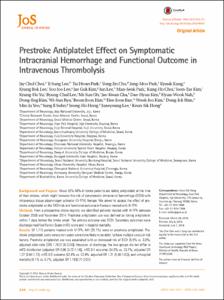Prestroke Antiplatelet Effect on Symptomatic Intracranial Hemorrhage and Functional Outcome in Intravenous Thrombolysis
- Keimyung Author(s)
- Sohn, Sung Il; Hong, Jeong Ho
- Department
- Dept. of Neurology (신경과학)
- Journal Title
- Journal of Stroke
- Issued Date
- 2016
- Volume
- 18
- Issue
- 3
- Abstract
- Background and Purpose About 30%-40% of stroke patients are taking antiplatelet at the time of their strokes, which might increase the risk of symptomatic intracranial hemorrhage (SICH) with intravenous tissue plasminogen activator (IV-TPA) therapy. We aimed to assess the effect of prestroke antiplatelet on the SICH risk and functional outcome in Koreans treated with IV-TPA.
Methods From a prospective stroke registry, we identified patients treated with IV-TPA between October 2009 and November 2014. Prestroke antiplatelet use was defined as taking antiplatelet within 7 days before the stroke onset. The primary outcome was SICH. Secondary outcomes were discharge modified Rankin Scale (mRS) score and in-hospital mortality.
Results Of 1,715 patients treated with IV-TPA, 441 (25.7%) were on prestroke antiplatelet. Prestroke antiplatelet users versus non-users were more likely to be older, to have multiple vascular risk factors. Prestroke antiplatelet use was associated with an increased risk of SICH (5.9% vs. 3.0%; adjusted odds ratio [OR] 1.79 [1.05-3.04]). However, at discharge, the two groups did not differ in mRS distribution (adjusted OR 0.90 [0.72-1.14]), mRS 0-1 outcome (34.2% vs. 33.7%; adjusted OR 1.27 [0.94-1.72), mRS 0-2 outcome (52.4% vs. 52.9%; adjusted OR 1.21 [0.90-1.63]), and in-hospital mortality (6.1% vs. 4.2%; adjusted OR 1.19 [0.71-2.01]). SimConclusions
Despite an increased risk of SICH, prestroke antiplatelet users compared to non-users had comparable functional outcomes and in-hospital mortality with IV-TPA therapy. Our results support the use of IV-TPA in eligible patients taking antiplatelet therapy before their stroke onset.
- Publisher
- School of Medicine
- Citation
- Kyusik Kang et al. (2016). Prestroke Antiplatelet Effect on Symptomatic Intracranial Hemorrhage and Functional Outcome in Intravenous Thrombolysis. Journal of Stroke, 18(3), 344–351. doi: 10.5853/jos.2016.00185
- Type
- Article
- ISSN
- 2287-6391
- Appears in Collections:
- 1. School of Medicine (의과대학) > Dept. of Neurology (신경과학)
- 파일 목록
-
-
Download
 oak-2017-0257.pdf
기타 데이터 / 479.39 kB / Adobe PDF
oak-2017-0257.pdf
기타 데이터 / 479.39 kB / Adobe PDF
-
Items in Repository are protected by copyright, with all rights reserved, unless otherwise indicated.